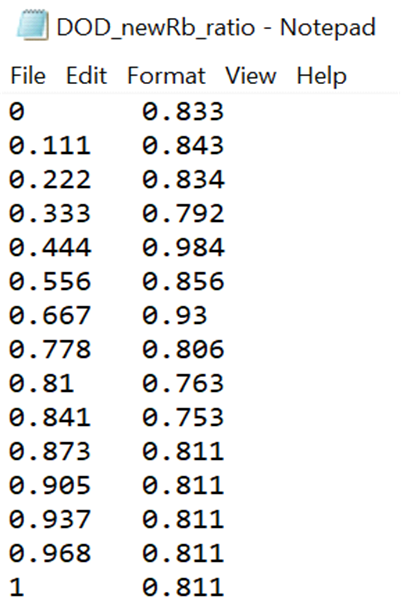SLUAA45 April 2020 BQ27Z561
-
End of Discharge SOC Jump Elimination
- Trademarks
- 1 Introduction
- 2 Improve Battery Modeling
- 3 Optimize Gauge Configurations
- 4 Achieve Successful Ra Table, Qmax and DOD0 Learning
- 5 References
2.2 Improve Battery Modeling -- Use GPCRB Tool to Optimize Low-Temperature Performance
SOC jump issue is more severe in very low temperature test, such as -15℃. Note that TI standardizes the modeling temperatures to 0℃, 25℃ and 50℃. ChemID was not operated at lower temperatures. it is recommended that the cells be characterized at 0℃ and that low temperature optimization tests can be performed using the online tool - GPCRB.
GPCRB is a dedicated tool to optimize low temperature performance of IT gauges. For IT gauges, resistance in data flash is normalized to 25°C as shown in Equation 1.

Where, DOD is the depth of discharge, R[DOD] is the measured resistance at a given DOD, Rb[DOD] is the temperature coefficient of impedance change at a given DOD stored as a reserved data flash table, and T is temperature in °C. GPCRB tool can modify the Rb values to improve Ra calculation accuracy in low temperature test, as shown in Figure 4, so as to improve SOC accuracy and relieve SOC jump problem at low temperature. This tool also obtains thermal model parameters that do not update in gauges, which helps with high rate tests accuracy. This tool provides Ra0_charge value as well, that helps to reach 100% SOC during charge more accurately.
 Figure 4. GPCRB Report – New Rb
Figure 4. GPCRB Report – New Rb GPCRB tool requires two log files of a relax-discharge-relax test performed under load and temperature conditions similar to an actual device, and also requires the gg file exported from your gauge EVM or device PCB using bqStudio after chosen ChemID data has been programmed. This tool will generate a new chemistry file that provides both improved resistance temperature compensation and learned values.